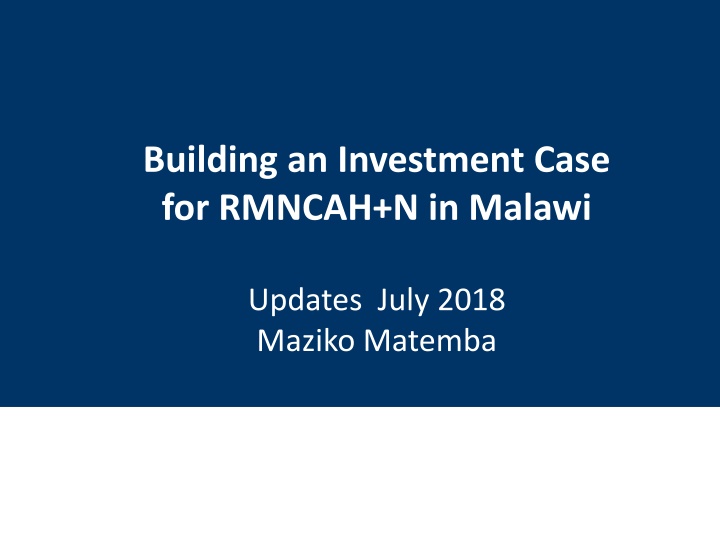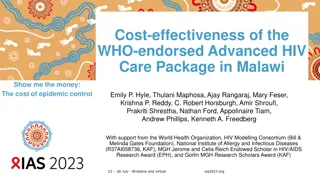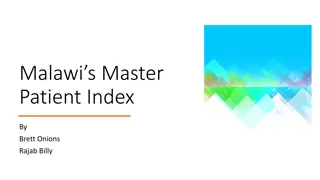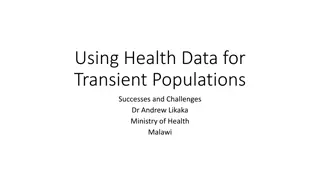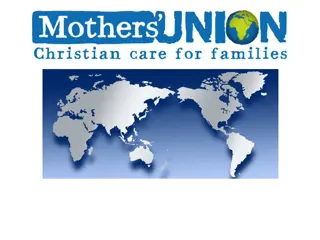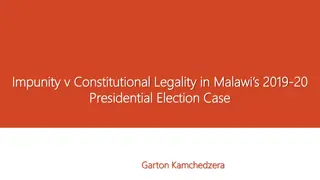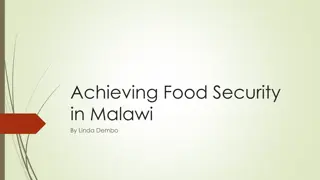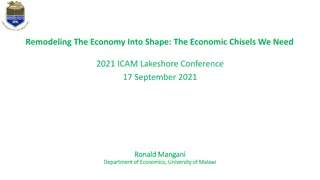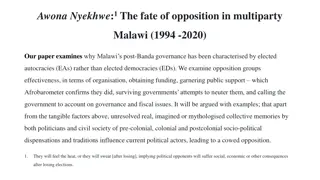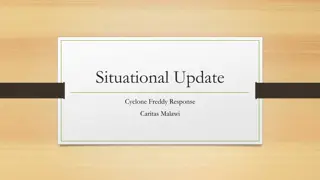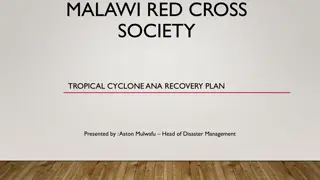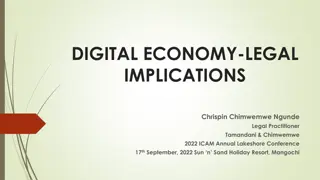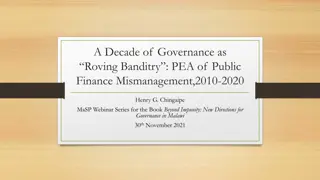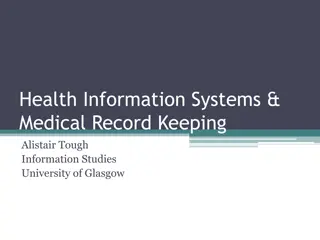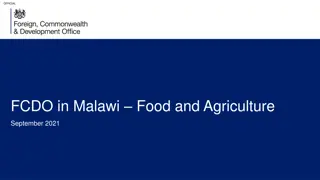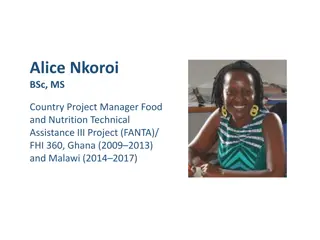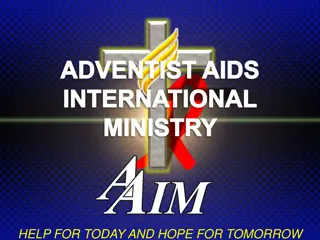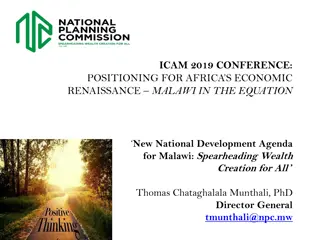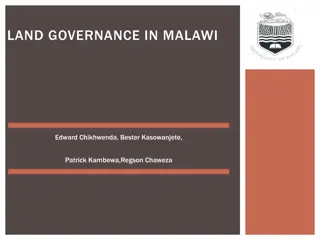for RMNCAH+N in Malawi
Annual funding gap for RMNCAH+N exceeds US$33 billion in high-burden, low- and lower-middle-income countries. Global Financing Facility works to close this gap in three ways, aiming to expedite Malawi’s attainment of SDGs and national priorities. GFF provides support through technical assistance, health financing, policy development, and direct grant funding, linked to World Bank IDA funding. Steps including determining the approach, collecting existing strategies, stakeholder analysis, and designing stakeholder engagement strategies are pivotal in the process.
Download Presentation

Please find below an Image/Link to download the presentation.
The content on the website is provided AS IS for your information and personal use only. It may not be sold, licensed, or shared on other websites without obtaining consent from the author.If you encounter any issues during the download, it is possible that the publisher has removed the file from their server.
You are allowed to download the files provided on this website for personal or commercial use, subject to the condition that they are used lawfully. All files are the property of their respective owners.
The content on the website is provided AS IS for your information and personal use only. It may not be sold, licensed, or shared on other websites without obtaining consent from the author.
E N D
Presentation Transcript
Building an Investment Case for RMNCAH+N in Malawi Updates July 2018 Maziko Matemba 1
Problem: Annual funding gap for RMNCAH+N exceeds US$33 billion in high- burden, low- and lower-middle income countries Source: Global Financing Facility 2
The Global Financing Facility works to close the gap in three ways By generating efficiencies through smart financing By crowding in additional domestic resources By further mobilizing development assistance for health and improving coordination of this assistance Source: Global Financing Facility 3
GFF can expedite Malawis attainment of SDGs and national priorities by catalyzing a new financing partnership for RMNCAH+N The Global Financing Facility in Support of Every Woman Every Child is a key financing platform of the UN Secretary General s updated Global Strategy for Women s, Children s and Adolescents Health (2016-2030) and aligns with the SGDs. Guiding Principles Country ownership International Health Partnership principles Emphasis on domestic resource mobilization Efficiency Result-focused It is a multi-stakeholder partnership that brings together, under national leadership and ownership, stakeholders in reproductive, maternal, newborn, child and adolescent health as well as nutrition (RMNCAH+N). Source: Global Financing Facility 4
The GFF provides support to countries like Malawi through two key channels 1) Technical Assistance Health financing and policy development (e.g. resource mapping, HF strategy development, etc.) Support for Investment Case development 2) Direct grant funding ( GFF grant ) Linked to World Bank IDA funding at 1:3 or 1:4 grant-to-loan ratio Current IDA: Investing in Early Years (IEY) ballpark $100M cap (TBD) GFF grant opportunity estimated at $10-$20M over 3-5 years 5
Step 1: Determine Approach Agree on what basis and form the Investment Case (IC) should take Collect existing strategies that are relevant to IC (e.g. HSSP II, SRH, FP, YFHS, Health Financing Strategy) Draft approach and workplan, including intermediate outputs and interactions among them Undertake extensive stakeholder analysis Agree on design of country platform anddraft stakeholder engagement strategy Activities 1. Investment Case Roadmap Timeline and Milestones Costed TA needs Clarity on linkage to Health Financing Strategy 2. Stakeholder Engagement Strategy and Country Platform Design Outputs 7
Step 2: Analyze situation and agree on results Collect and analyze data on RMNCAH+N situation Agree on the results/milestones/targets to be achieved with IC Collect and analyze both existing and new data (as needed) on RMNCAH+N interventions/outcomes Focus on equity, efficiency, multi-sectoral determinants, and upcoming structural shifts Prioritize results: Determine which aspects of the RMNCAH continuum and the health system to focus on Define Targets: Determine where the country wants to go until 2030, including 3-5 year targets and how trajectory differs from the status quo Activities Analytical outputs as defined in workplan Agreement on result areas, 2030 targets, 5-year milestones Outputs 8
Step 3: Bottleneck Analysis and Potential Investments Refine and amend HSSP II/other strategies based on 2030 goals Identify key bottlenecks (e.g. EQUIST) Identify priority high-impact interventions (e.g. LiST) Develop core strategies to address system bottlenecks Develop multi-sector interventions, including CRVS Activities Articulated list of bottlenecks (RMNCAH+N specific and system-wide) Articulated strategy of strategies and interventions to address them, including strong justification Refined or amended HSSP II/other strategies to incorporate the above elements (refer to initially-agreed IC basis ) Outputs 9
Step 4: Costing, Cost Effectiveness, and Resource Mapping Assess costs/cost-effectiveness of proposed interventions Map resources potentially available for the above costed need Cost draft strategies and interventions (including multisectoral components) could be based on previous costings Retrieve Resource Mapping Round 5 data on RMNCAH+N total projected resources available Activities Costed interventions and strategies Resource availability analysis against costs (i.e. financial gap analysis) Outputs 10
Step 5: Prioritization and Maximization of Returns on Investment Identify priority interventions and strategies that can be implemented within the available resources Prioritize wishlist of strategies and interventions to create a financially realistic proposal Explore efficiency opportunities to reduce costs of proposed strategies and interventions If appropriate, scenario analysis with different sets of interventions, strategies, and scale-up Activities Clear set of prioritized strategies and interventions that fit within resource envelope Outputs 11
Step 6: Monitoring and Evaluation Define results framework approach for monitoring and evaluating progress Develop results framework and indicators for monitoring and evaluation, including M&E of financing Identification of key investments required for M&E (including CRVS) Activities 3-5 year Results Framework List of key indicators M&E implementation plan, including investment planning Outputs 12
Step 7: Mobilize, Pool, and Coordinate Resources for IC Agreement among government agencies and partners on the financing of the Investment Case Conduct detailed resource mapping and gap analysis to identify over- and under-funded areas of the IC Secure domestic commitments for plan Secure external commitments for plan Activities Documentation of high-level agreement among: Government and partners Government agencies (MoF, MoH, and other MDAs) Detailed investment framework mapping out IC funding status and commitments Outputs 13
Step 8: Draft Investment Case Document and finalize the Investment Case for submission Identify documentation requirements of IC Develop outline and components of IC Write up technical components of IC Finalize cost/quantitative components of IC Circulate for feedback and finalize Activities Completed and validated investment case package for submission to WB/GFF Trust Fund Board Committee Outputs 14
Jan Nov Nov Dec Feb Design stakeholder engagement strategy and Country Platform (CP) Engage stakeholders via CP Determine approach through govt- partner dialogue Update situation assessment Using existing strategies and latest data (epi, population, HSS, etc.) LAUNCH MEETING Assess TA needs against workplan Supplement with analyses (e.g. equity, efficiency, multi-sectoral determinants, demand-side factors, etc.) Agree on goals, including 2030 targets, and 3-5 year milestones Identify bottlenecks and priority interventions to address them (RMNCAH+N and systems strengthening; health and multi-sector)
May Nov Mar Apr June Continued stakeholder engagement via Country Platform Validate high-level resource envelope for RMNCAH+N Update costs for priority strategies and interventions (including multi- sector approaches) High-level gap analysis: Total Resources Total Costs = Gaps IC SUBMISSION PRIORITIZE High-impact interventions Detailed gap analysis Identify over- and under- funded areas Conclude negotiations Secure commitments onto largest gaps (domestic + external) Draft Investment Case Finalize IC
SWOT Analysis: Strengths Existing relevant national strategies and plans with RMNCH components or focus Useful multi-stakeholder engagement platforms Engagement of the private sector CHAM through Service Level Agreements EQUIST updated to 2015 Preliminary situation analyses informed development of new national strategies 17
SWOT Analysis: Weaknesses Incomplete situation analysis (in terms of equity, efficiency, multi- sectoral determinants and demand side factors) Current approaches are limited to health sector with little attention to multi-sectoral determinants No RMNCAH+N-focused resource mapping Low domestic financing for health and low potential for expansion Limited involvement of the private sector (apart from CHAM) in strategic planning 18
SWOT Analysis: Opportunities Political will at Presidency and Ministry of Health: Minister of Health prioritizes aid coordination for RMNCAH and civil registration and vital statistics; Leverage existing strategies and policies to develop investment case Leverage existing health financing reforms to finalize a comprehensive health financing strategy Leverage existing government-led collaborative platforms to create the GFF Country platforms. Prioritize RMNCAH+N in EHP Implementation 19
SWOT Analysis: Threats Unpredictable political economy with upcoming elections Bureaucracy in review and approval of investment case and strategy Delayed negotiation with Treasury on terms of IDA finance Non-alignment of country priorities with World Bank expectations Supply chain management issues drug pilferage Implementation challenge with decentralization 20
Immediate Steps from now through December 15 Agree on Basis of Investment Case 1. Collect, validate, and review existing strategies, policies, and evidence to inform situation analysis 2. Agree on which/how the above evidence will be used to form basis of investment case Planning: 1. Validate draft workplan with roles and responsibilities, cost it, and identify TA needs 2. Plan and mobilize partner TA through IC submission Stakeholder Engagement: 1. Map stakeholders, develop engagement strategy, and design country platform 2. Plan for Global Financing Facility Launch in January 2018 21
Stakeholders Government MoH,MoF,Education,Gender and Agriculture. Multilateral institutions WHO, UNICEF, UNFPA, World Bank, EU International organizations Global Fund Bilateral donors USAID, DFID, GIZ, SIDA NGOs-Local and International Civil society-Local and International Private sector-CHAM and Others Others? 22
Strategy/Policy Mapping for discussion Malawi Growth and Development Strategy Health Sector Strategic Plan II Community Health Strategy Reproductive Health Strategy (Draft) Roadmap for Accelerating the Reduction of Maternal and Neonatal Mortality in Malawi Every Newborn Action Plan: An Action Plan to end Preventable Deaths in Malawi Malawi Costed Implementation Plan for Family Planning IMCI Approach Policy for Accelerated Child Survival and Development Youth Friendly Health Services Strategy Child Health Strategy Others? 23
Draft Roadmap Progress as of June 2018 Finalize and validate the roadmap and submit to GFF and World Bank: to submit for inputs by week from 18th, June Full time Coordinators (2) of the overall process co-financed by UNICEF, WB, BMGF by end June Unicef Regional office to share information from on investment case ( IC )from other GFF countries (Mozambique, Kenya, Uganda) by end June All groups- Internal (MNH, Child Health, WASH&Nutrition) to finalize Equist scenarios (prioritized districts, rest of the country) --- by end June Launch of the GFF Roadmap (early July) Non-Equist (Adolescent/SRH, NCD, investment in early years, decentralized registration/CRVS, Enabling Environment): engage the right stakeholders --- by Agriculture, Education, Gender, Youth; (early July), Obtain draft working areas (revised ToC) (early July) Health financing strategy : MoH and MoFA (July) MoH to organize consultative workshop to finalize prioritization scenarios (mid July) Write up (start by end of July and early August 2018) Submission September 2018 24
Examples Some CSOs Platforms Roles Facilitate coordination of CSOs to enhance information sharing for advocacy in relation to the implementation of the Investment Case for RMNCAH + Nutrition. Strengthen and capacity building of CSOs, and other stakeholders regarding the implementation of the Investment Case. Coordinate the development of the engagement strategy and follow up for accountability; and Support the development of relevant accountability tools and processes. 25
Thank you 26
